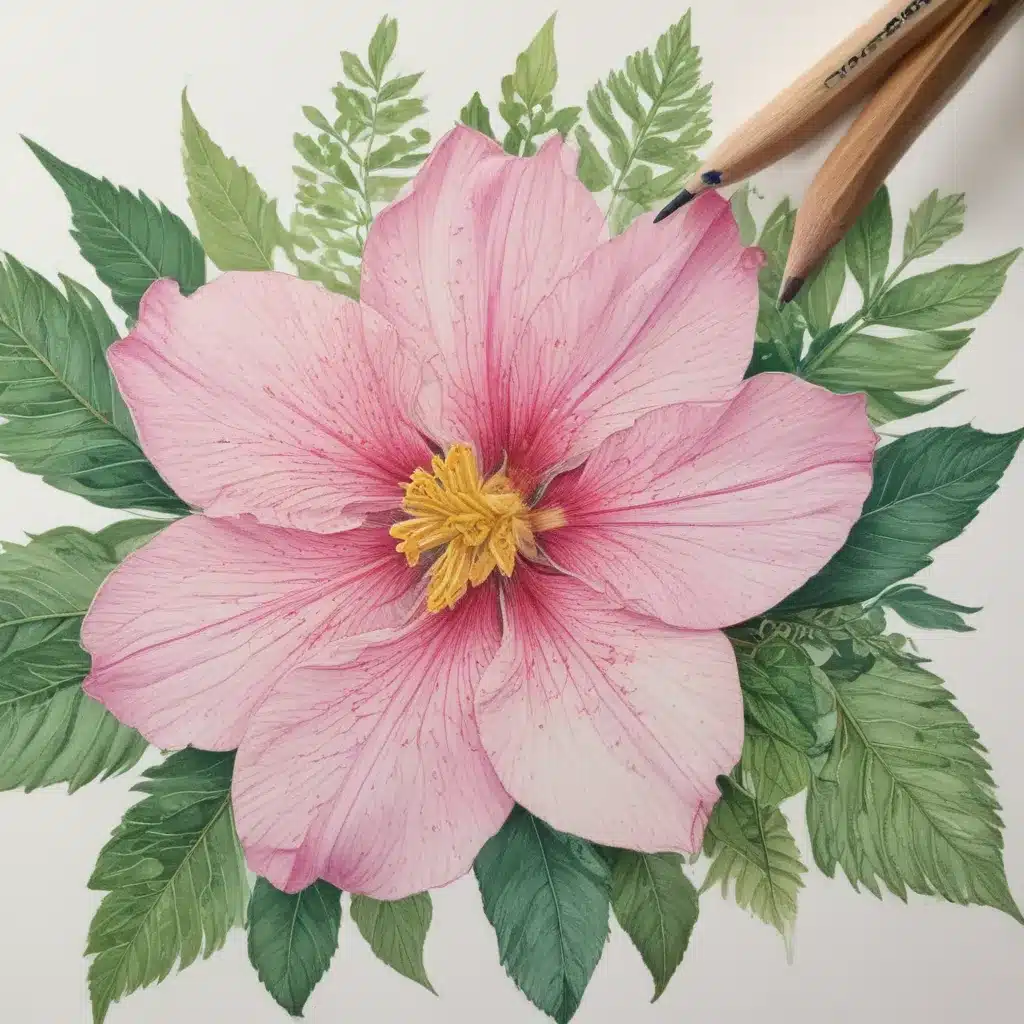
In the captivating world of botanical art, the delicate balance between realism and abstraction can elevate a simple floral motif into a richly expressive work of art. Coloured pencil, with its versatility and precision, has emerged as a medium of choice for artists seeking to capture the intricate beauty of the natural world while infusing their creations with a distinct personal touch.
Now, this might seem counterintuitive…
Mastering Coloured Pencil Techniques
The art of coloured pencil illustration is a complex and nuanced practice, requiring a deep understanding of the medium’s unique qualities. From the careful layering of hues to the skilful blending of tones, each stroke holds the potential to transform a botanical subject into a visually striking composition.
Layering and Blending: One of the hallmarks of expressive botanical coloured pencil art is the masterful layering and blending of colours. By strategically building up transparent layers, artists can create a sense of depth and luminosity within their floral subjects. Subtle gradations and seamless transitions between hues breathe life into the delicate petals and lush foliage.
Photorealistic Rendering: For those seeking a more realistic approach, the coloured pencil medium offers unparalleled precision. Through careful attention to detail and a deep understanding of form, light, and shadow, artists can achieve a level of photorealistic rendering that captivates the viewer. The ability to render every vein, pore, and filigree of a flower’s surface is a testament to the medium’s versatility.
Textural Exploration: Coloured pencils also lend themselves well to the exploration of texture. By varying the pressure, layering techniques, and interplay of hard and soft edges, artists can evoke the nuanced surfaces of botanical subjects, from the silky smoothness of petals to the rugged bark of stems.
Balancing Realism and Abstraction
The interplay between realism and abstraction is a hallmark of the most compelling botanical coloured pencil illustrations. While some artists strive for a meticulous, true-to-life representation of their subjects, others embrace a more expressive, stylized approach.
Juxtaposition of Styles: By strategically juxtaposing realistic and abstract elements within the same composition, artists can create a captivating visual dialogue. A botanically accurate rendering of a flower’s structure might be offset by the abstract, gestural treatment of its surroundings, for example, inviting the viewer to engage with the work on multiple levels.
Expressive Simplification: In contrast, some botanical artists find inspiration in the bold, simplified forms of their subjects. By distilling a flower down to its essential shapes and colours, they can imbue their works with a striking, emotive quality. This approach often relies on a strong sense of composition and a keen eye for the interplay of positive and negative space.
Symbolic Representation: The use of abstraction in botanical coloured pencil art can also lend itself to symbolic representation. By emphasizing certain elements or infusing the work with personal, conceptual meaning, artists can create visually striking pieces that transcend the purely representational and tap into deeper, universal themes.
The Art of Observation
At the heart of every compelling botanical coloured pencil illustration lies a deep, sustained engagement with the natural world. Whether working from life, photographs, or a combination of the two, the most successful artists bring a keen eye for detail and a genuine curiosity to their practice.
Drawing from Life: The act of drawing directly from observation, whether in the studio or en plein air, allows artists to develop an intimate, tactile understanding of their botanical subjects. The process of carefully rendering every nuance of form, texture, and colour can foster a profound connection with the natural world, informing the artist’s creative vision.
Photographic References: For many botanical artists, photographic references serve as invaluable tools for capturing the intricate details of their subjects. However, the most accomplished practitioners do not merely copy their references but rather use them as springboards for personal interpretation and expressive exploration.
Imaginative Interpretation: By synthesizing their observational studies with an imaginative, intuitive approach, botanical artists can imbue their works with a profound sense of vitality and emotional resonance. The interplay between realism and abstraction, between the observed and the imagined, is where the true magic of botanical coloured pencil art emerges.
Tutorials and Creative Inspiration
For aspiring botanical artists, the wealth of online resources and educational opportunities can be both exciting and overwhelming. Whether you’re drawn to the precision of photorealistic rendering or the expressiveness of a more abstract approach, there are a myriad of techniques and creative processes to explore.
One invaluable resource for botanical art enthusiasts is the New York Botanical Garden’s Certificate Program, which offers a comprehensive curriculum covering everything from fundamental drawing skills to advanced coloured pencil techniques. By immersing themselves in this rigorous, yet nurturing program, aspiring artists can develop a robust foundation in the discipline while honing their own unique artistic voices.
For those seeking a more free-flowing, experimental approach, the Brush Movement blog offers a wealth of insights and practical advice on the art of painting loose, abstract botanicals. By embracing the inherent unpredictability of the medium and letting go of the need for control, artists can discover new avenues for creative expression.
Ultimately, the world of botanical coloured pencil art is one of boundless possibilities, where the interplay of realism and abstraction can give rise to truly mesmerizing, emotionally resonant works. Whether you’re drawn to the precision of photorealistic rendering or the expressive, intuitive qualities of a more stylized approach, the key lies in cultivating a deep, abiding connection with the natural world and a willingness to explore the full range of the medium’s capabilities.
Example: Modern Abstract Painting Series 2024